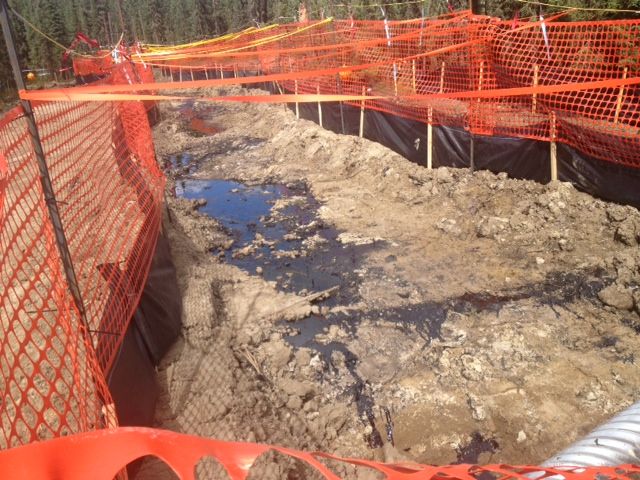For the first time, Canadian Natural Resources, Ltd. has admitted a series of never-ending spills on its property could be caused, or at least exacerbated, by its own high-pressure steaming.

Environmentalist critics have been saying so for years. Energy Resources Conservation Board (regulator before Alberta Energy Regulator) suggested as much in its report on another, similar spill in 2009.
But for more than a year, CNRL stuck with its original story: That faulty wellbores – old holes in the rock used to extract bitumen from operations long defunct – were to blame.
Then in a report this month, the industry giant acknowledged its high-pressure steaming practices could have fractured the cap rock and cause four bitumen leaks at its site in Cold Lake, Alberta.
That said, the company has no plans to change its practices or the mitigation strategies it’s been using for more than a year.
READ MORE: Regulator gives company green light to resume operations near spill site
The leaks, discovered in the spring of 2013, have seeped thousands of barrels of bitumen emulsion to the surface. They show no sign of stopping.
The Alberta Energy Regulator wouldn’t comment on the report because of an ongoing investigation into the spills.
CNRL pumps steam into the ground to build up pressure, soften bitumen and bring it to the surface in a process call high-pressure cyclic steaming stimulation.
- 2021 heat dome fuelled by climate change, intensified wildfire risk: study
- B.C. introduces legislation recognizing Haida Gwaii Indigenous title
- Whale experts confident B.C. orca calf will survive, find family if rescue plan succeeds
- Plastic production cap still contentious as Ottawa set to host treaty talks
Its latest report found that natural weaknesses in the cap rock and the company’s own steam-induced pressure may have cause the bitumen to flow to the surface.
READ MORE: Months into CNRL spills, questions about why more wasn’t done after 2009 report
That’s a key admission, Chris Severson-Baker, Managing Director of the Pembina Institute argued in a blog after the report’s publication: The project’s approval rests on the premise the cap rock wouldn’t crack, he wrote.
Greenpeace is calling on the government to stop CNRL’s activities at Primrose and any other site that uses cyclical steam stimulation until the investigation is complete.
The are a lot of them: Steam-based bitumen extraction is one of the fastest-growing ways to get bitumen out of the ground in Alberta.
“The government can’t continue to let its lack of knowledge compromise safety. We need answers before Alberta faces yet another unexplained disaster,” Greenpeace Climate and Energy campaigner Mike Hudema said in a statement.
So far, CNRL says it’s spent the past year fixing “defective” wellbores, enhancing its monitoring and changing the volume of steam it’s pumping into ongoing operations, CNRL spokesperson Zoe Addington said via email.
There haven’t been any new modifications since the report was released.
And it’s “most likely mechanical failure of wellbores” that provide a pathway for the spilling bitumen, Addington said via email, adding that there’s only a “very low probability” that fractured cap rock provides a way for bitumen to leak.
That reluctance to confirm high-pressure steaming is the problem is because doing so would call into question the whole design on the project,” Severson-Baker said.
The Primrose project could make the regulators reassess whether the approval of high-pressure cyclical steam stimulation was valid, given the likelihood the cap rock is compromised, he said.
But the implications go beyond this one site: Problems with this extraction method could jeopardize operations across norther Alberta, where much larger return on high-pressure steaming provides a significant incentive for companies in less economical reserves in Alberta.
READ: CNRL’s spill causation report





Comments